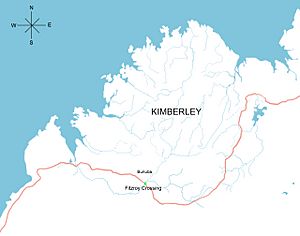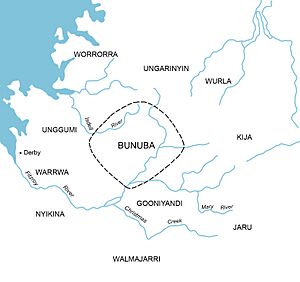Bunuba language facts for kids
Quick facts for kids Bunuba |
|
|---|---|
| Bunaba, Bunapa, Punuba, Punapa, Punaba, Buniba | |
| Native to | Western Australia |
| Region | Kimberley (Western Australia) |
| Ethnicity | Bunuba |
| Native speakers | 150 (2021 census) |
| Language family |
Bunuban
|
| AIATSIS | K5 |

Bunuba Country near Fitzroy Crossing, Kimberley Region of Western Australia
|
|
Bunuba is an Aboriginal language spoken by the Bunuba people in Western Australia. Most speakers live in Junjuwa, a community near Fitzroy Crossing. In 2021, about 149 people spoke Bunuba.
Bunuba is special because it is not part of the large Pama-Nyungan language family that covers most of Australia. Instead, it belongs to the smaller Bunuban language family. It is closely related to the Guniyandi language. Bunuba has two main ways of speaking, called dialects: 'light' Bunuba and 'heavy' Bunuba.
Bunuba elders are working hard to keep their language alive. They share stories with younger community members around campfires. This helps pass the language down through generations. In recent years, more people have been documenting Bunuba. New learning materials have also been created by Bunuba community members.
Contents
Discovering the Bunuba Language
Early Studies of Aboriginal Languages
In 1919, a linguist named Wilhelm Schmidt (linguist) noticed differences between Aboriginal languages in Australia. He grouped them into northern and southern types. The northern languages, like Bunuba, are now known as Non-Pama-Nyungan languages.
Recording Bunuba: Arthur Capell's Work
From 1938 to 1989, an Australian linguist named Arthur Capell visited the Northern Territory. He recorded features of languages from the Kimberley (Western Australia) region, including Bunuba. His studies helped classify many Aboriginal languages. His work is now kept at the Australian Institute of Aboriginal and Torres Strait Islander Studies in Canberra.
Modern Research on Bunuba
Since the 1960s, linguists have used new methods to study Aboriginal languages. Howard Coate made audio recordings of Bunuba conversations in the mid-1960s. These recordings are also at the Australian Institute of Aboriginal and Torres Strait Islander Studies.
Later, Alan Rumsey worked closely with the Bunuba community from the 1970s to the 1990s. He focused on how Bunuba sentences are built (its syntax) and how words are formed (its morphology). He also studied its sounds (its phonology).
How Bunuba is Classified
Bunuba is a Non-Pama-Nyungan language. This means it is not part of the large Pama–Nyungan languages family. It is a subgroup of the Bunuban language family.
Bunuba's Unique Grammar
Arthur Capell noted that Bunuba does not use noun classes or grammatical gender. For example, in English, we use "he" for boys and "she" for girls. But Bunuba uses one word, niyiŋga, for "he," "she," or "it."
Languages Similar to Bunuba
Bunuba Country is surrounded by areas where other Non-Pama-Nyungan languages are spoken. These include Guniyandi, Gija, Ngarinyin, Nyigina, Unggumi, and Warrwa.
Linguists compare how many words languages share to see how similar they are. They often use a list of 100 basic words. Here's how Bunuba compares to some of its neighbours:
| Non-Pama-Nyungan Language | Percentage of Similarity |
|---|---|
| Guniyandi | 45% |
| Ungarinyin | 24% |
| Walmajarri | 24% |
| Kija | 20% |
| Unggumi | 20% |
| Nyikina | 15% |
| Warrwa | 11% |
Bunuba and Guniyandi: Close Relatives
Guniyandi is the most similar language to Bunuba. However, speakers of Bunuba and Guniyandi cannot easily understand each other. They are both part of the larger Bunuban family. About 45% of Bunuba's basic words are also found in Guniyandi. This shows their close connection within the Bunuban family.
Different Ways of Speaking Bunuba
Bunuba has two regional dialects: 'light' Bunuba and 'heavy' Bunuba. The 'light' dialect is spoken in the eastern and southern parts of Bunuba Country. The 'heavy' dialect is used in the northern and western parts. The 'heavy' dialect is also called Unggumi Bunuba because it shares sounds with the Unggumi language.
The main difference between the two dialects is in some of their sounds. For example, the 'light' dialect uses a 'y' sound. The 'heavy' dialect often uses a 'yh' sound instead. This difference can be heard in the word for 'meat'. 'Light' speakers say /miya/, while 'heavy' speakers say /miyha/. Even with these differences, speakers of both dialects can usually understand each other easily.
Bunuba Sounds
Consonant Sounds
Bunuba has many consonant sounds. They are made by different parts of the mouth. The table below shows the main consonant sounds in Bunuba.
| Peripheral | Laminal | Apical | ||||
|---|---|---|---|---|---|---|
| Labial | Velar | Palatal | Dental | Alveolar | Retroflex | |
| Stop | b /b/ | g /g/ | ɟ /j/ | t̪ /th/ | d /d/ | ɖ /rd/ |
| Nasal | m /m/ | ŋ /ng/ | ɲ /ny/ | n̪ /nh/ | n /n/ | ɳ /rn/ |
| Rhotic | r /rr/ | ɽ /r/ | ||||
| Lateral | ʎ /ly/ | l /l/ | ɭ /rl/ | |||
| Approximant | w /w/ | j /y/ | ɹ̪ /yh/ | |||
Bunuba has six places where sounds are made in the mouth. These are grouped into three main types:
- Peripheral sounds use the lips or the back of the tongue (like 'b' or 'g').
- Laminal sounds use the middle of the tongue (like 'j' or 'th').
- Apical sounds use the tip of the tongue (like 'd' or 'rd').
Vowel Sounds
Bunuba has three basic vowel sounds: /i/, /a/, and /u/. The /a/ sound can be short or long. This means it can be pronounced for a shorter or longer time.
| Front | Central | Back | |
|---|---|---|---|
| High | i /i/ | u /u/ | |
| Low | a /a/, aː /aa/ |
Bunuba Grammar Basics
Parts of Speech
In Bunuba, words can be grouped into different types, like in English.
- Nominals: These are words that can have other parts added to them.
- Verbs: These are action words. They often have small parts added to the beginning or end that change their meaning.
- Adverbs: These words describe verbs. They are usually standalone words.
- Pronouns: These words replace nouns (like 'he', 'she', 'they'). They show if something is singular or plural.
- Kin terms: These are words for family members. They can show who owns something or how many people there are.
Repeating Words for Meaning
Bunuba often repeats parts of words or whole words. This is called reduplication. It can show that there is more than one of something (plural).
For example:
- To say "little ones" (many children), they say ma-mabilyi. This comes from mabilyi, meaning "little."
- To say "their husbands" (many husbands), they say nhungu-nhungu-way. This comes from nhungu-way, meaning "her husband."
Reduplication can also make words stronger or more intense.
- gililandirri means "very big." It comes from gilandirri, meaning "big."
Saving and Sharing Bunuba
Kimberley Language Resource Centre
The Kimberley Language Resource Centre (KLRC) was started in 1984. Its goal is to help keep Aboriginal languages, like Bunuba, strong and alive.
Helping the Community
KLRC helps people from language groups find jobs that use their language skills. They offer training to community members. This helps them work in fields where their language is needed.
Creating a Bunuba Alphabet
Before 1989, there was no set way to write Bunuba words. This made it hard to study the language clearly. In 1989, KLRC worked with about twenty Bunuba speakers to create an orthography (a writing system). This system was then used to make an illustrated Bunuba wordbook in 1991. This book is still used today to teach and learn the language.
Storing Language Resources
KLRC has many old and new language materials. These include recordings and documents from linguists who studied Kimberley languages. KLRC also works with the Australian Institute of Aboriginal and Torres Strait Islander Studies (AIATSIS). Together, they return language resources to Indigenous communities. KLRC has audio, video, and book formats of Bunuba language materials.
Thangani Bunuba (Bunuba Stories)
Thangani Bunuba is a book of stories told by twelve Bunuba elders. It was created to help save and maintain the Bunuba language. The elders asked for this project so their language could be preserved. They worked with linguists and language workers from KLRC to translate the stories into English.
The book includes traditional paintings alongside the stories. Audio recordings were made of each story. These recordings were then written down and translated into English. The book also has a "Guide to Bunuba Pronunciation." This guide helps people learn how to say Bunuba words using English sounds as a guide.
Bunuba in Theatre
The Story of Jandamarra
Jandamarra was an Aboriginal Australian man and a leader of the Bunuba people in the late 1800s. He was known for leading resistance against European settlers in the southern Kimberley (Western Australia) region. Jandamarra's life story has been shared in many ways, including a 2008 play called Jandamarra. This play included dialogue in the Bunuba language.
The Jandamarra Stage Play
The 2008 play was based on a 1995 book called Jandamarra and the Bunuba Resistance. This book was written by historian Howard Pedersen and Bunuba elder Banjo Woorunmurra. The Bunuba company, Bunuba Films, worked with the Black Swan State Theatre Company to create the play.
The play went on a tour in 2011, called The Jandamarra Returns Tour. It had thirteen shows in places like Broome and Kununurra. Over 5,000 people watched the play.
To make the play feel more real, the playwright, Steve Hawke, decided to use Bunuba language and Kimberley Kriol in some scenes. Linguists and language coaches helped during workshops in 2007. Four Bunuba women, Mona Oscar, Patsy Bedford, June Oscar, and Selina Middleton, helped translate the script. They made sure the cultural meaning was kept. The translations were shown on a screen as surtitles so the audience could understand. Bunuba elders also taught the language to the actors. The main actor, Damion Hunter, received special language coaching. The play also featured Yilimbirri Junba, a traditional Bunuba song and dance.


